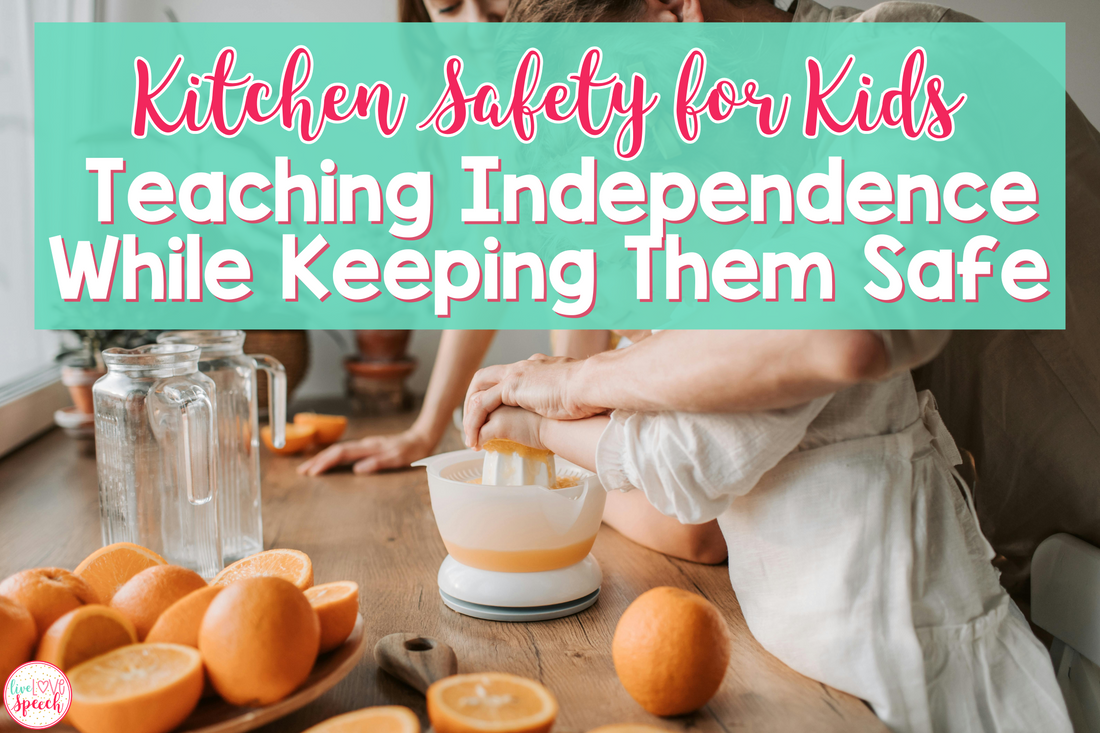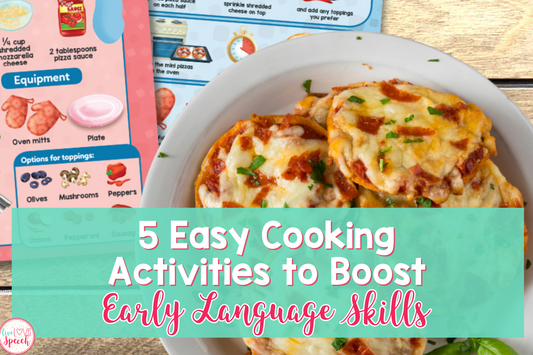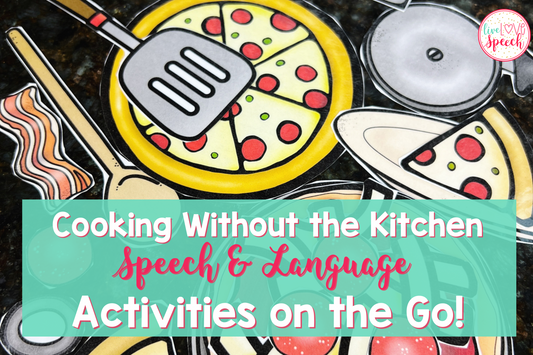 Cooking with kids is a big part of my life, not just as an SLP, but as a mom too. Whether it’s a quick no-bake treat after school or prepping dinner on a weekend, the kitchen is one of our busiest (and most fun) spaces. But let’s be honest, teaching kids to cook isn’t just about the fun. It’s also about safety, building confidence, and encouraging independence along the way.
Cooking with kids is a big part of my life, not just as an SLP, but as a mom too. Whether it’s a quick no-bake treat after school or prepping dinner on a weekend, the kitchen is one of our busiest (and most fun) spaces. But let’s be honest, teaching kids to cook isn’t just about the fun. It’s also about safety, building confidence, and encouraging independence along the way.
In this post, we will discuss kitchen safety tips for kids that can help make your cooking time smoother, safer, and a little less stressful. If you're looking for ideas that promote real-life learning and communication, you're in the right place.
Choosing Recipes and Prepping the Environment
Before you even grab the ingredients, one of the best ways to make your cooking session successful is to start with the right recipe. Pick something simple, visual, and easy to prep. This is especially important for new cooks or children with speech or sensory differences.
I always recommend starting with visual recipes. They break tasks into clear, step-by-step instructions using images, which supports language development, comprehension, and independence. You can find a variety of them in the Visual Recipe Cards, perfect for making things like smoothies, no-bake treats, and even full meals.
Once you’ve chosen your recipe, take time to prep the environment. Set up a kid-friendly workspace, pull out tools in advance, and walk through what’s going to happen. You can even preview the steps using a visual schedule or checklist to help kids know what to expect before jumping into their specific roles. Now, let’s walk through six practical kitchen safety tips for kids that support skill-building and independence at any age. Here are six practical ways to support kitchen safety, skill-building, and independence at any age.
For more ideas that keep cooking efficient and manageable, check out Kids’ Cooking Activities in 30 Minutes or Less. It’s packed with quick ways to get your kids learning without spending your whole day in the kitchen.
Kitchen Safety Tips
1. Age-Appropriate Tasks
It’s important to match kitchen jobs with developmental levels. Assigning the right responsibilities can build confidence and prevent safety concerns, which is why matching the task to the child’s age and skill level is so important. Here are five different ways to tailor tasks by age group and keep everyone both safe and engaged.

Toddlers (2–3): Stir, sprinkle, rinse fruits, or tear lettuce.
Preschoolers (4–5): Mash, mix, spread, and use cookie cutters.
School-Age (6–8): Measure ingredients, peel with a safe peeler, and cut with plastic or nylon knives.
Tweens (9–12): Follow simple recipes, use small appliances under supervision, and learn to use the stove safely.
This blog post on Cooking Safety Tips for Kids dives deeper into matching kitchen tools and jobs to different age groups, if you want even more ideas.
2. Introducing Tools Safely
Start by demonstrating how to hold and use each tool. From knives to peelers to graters, it’s helpful to model what to do before letting kids try it themselves.
Start small by introducing kid-safe tools, such as nylon knives or finger guards. As they build skills and confidence, they can graduate to real tools with supervision.
A sensory-friendly visual recipe like Beach Pudding Cups from the July Visual Recipes Set is a great way to keep the activity engaging without overwhelming sensitive learners. These recipes break steps down visually and include sensory-friendly tasks that meet kids where they are.

3. Establishing Clear Rules
Setting expectations from the beginning helps prevent confusion and injuries. Think about the common kitchen rules and explain not just what to do, but why it matters.
Some easy-to-remember rules:
Always turn pot handles inward
Ask an adult before using anything sharp or hot
Wash your hands before and after cooking
Reinforce these rules often. You can even create a visual rule chart to post in your kitchen so everyone’s on the same page.
4. Using Visual Cues
Visuals can be a huge part in supporting safety and understanding. Try color-coded stickers on tools to mark which are safe for kids to use and which are not.
You can also use step-by-step guides, safety checklists, or even a picture of what a “clean-up station” looks like. This is another place where visual recipes shine, especially my Visual Recipe Cards. These guides offer built-in visual cues for each step, helping kids stay focused and safe while building independence.

Need ideas on making your kitchen work better for communication and visuals? Don’t miss 5 Tips for Creating a Speech-Friendly Kitchen, which covers everything from labels to seating to functional routines.
5. Hands-On Safety Practice
You can talk about safety all day, but giving kids a chance to practice is where it really sticks.
Role-play what to do when something spills, how to safely turn off appliances, or how to respond to a minor burn. Practicing first-aid basics (like rinsing a burn or using oven mittens) helps build real-world readiness.
You can also assign a mini "safety officer" job for older kids to check the setup before starting a recipe. It positively builds responsibility.
6. Teaching Independence While Keeping Them Safe
Letting kids take the lead in the kitchen doesn’t have to mean lowering safety standards. In fact, giving them age-appropriate responsibility helps them take ownership of safety.
Use visual recipes to empower them to follow directions and self-correct without needing constant reminders. They’re especially effective for kids who benefit from clear expectations and a concrete sequence.

Try tasks like:
-
Choosing and gathering ingredients
-
Cleaning up spills
-
Setting timers
-
Reading step-by-step recipe visuals aloud
Success builds confidence. When kids feel capable, they’re more likely to follow safety rules and develop healthy kitchen habits.
And if you’re ready to dive deeper, check out these helpful resources:
Cooking together becomes more meaningful and safe when we plan ahead, empower kids, and work side by side.
For more ideas, tips, and resources, be sure to check out my other blog posts. Let's keep making learning enjoyable for both you and your child!






